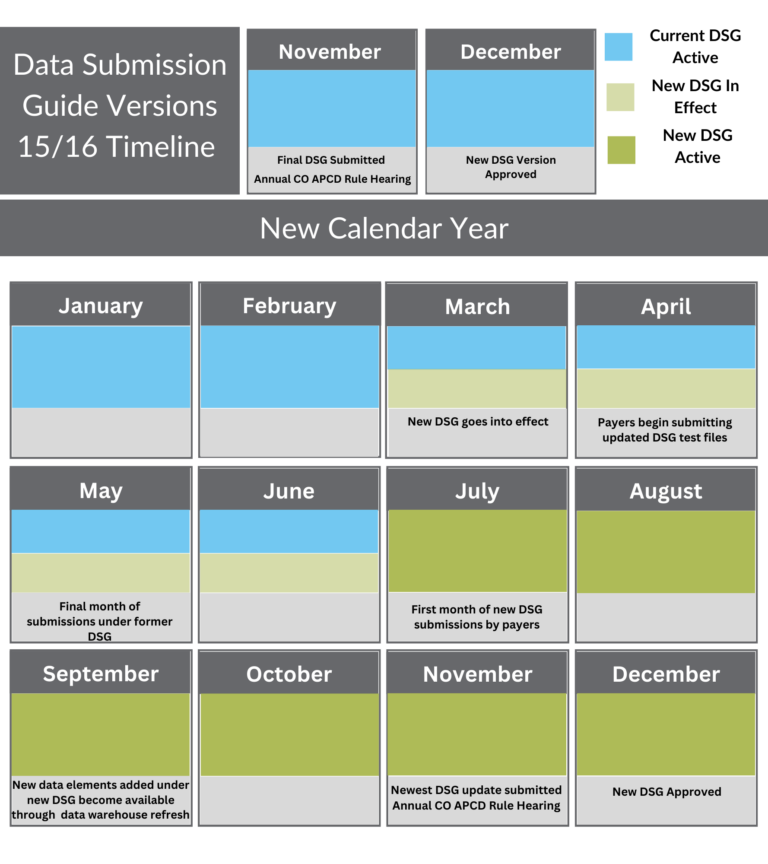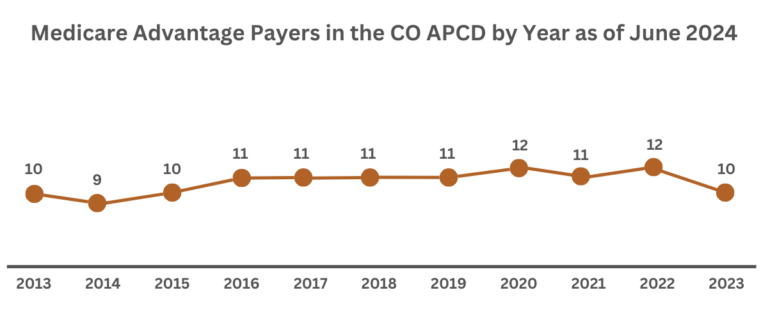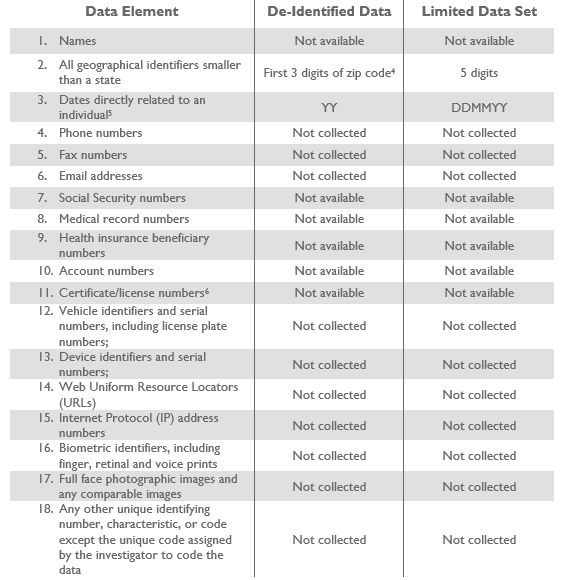Overview
The CO APCD contains millions of claims across all health plans for multiple years. Health insurance payers submit data monthly and the entire database is refreshed every other month, so the CO ACPD is continually evolving and being enhanced.
Data Warehouse Refresh Resources
The CO APCD Data Warehouse is refreshed every other month, incorporating new years of data while also improving the quality of the existing data by implementing new business rules, adding previously missing files, or correcting concerns. The breakdown of paid-through dates by business line for the most recent refresh is available here.
The Release Notes for the most recent refresh is now available for download and provides important information regarding the length of time between the service date and paid date (‘claims lag’) for medical and pharmacy claims in the CO APCD. This analysis helps answer several key questions including how long it takes to achieve “completeness,” how lag time varies by payer type (commercial, Medicaid, etc), and by claim type (medical, pharmacy, inpatient, outpatient, etc).
Query: CO APCD Data Quality
The Query: CO APCD Data Quality series is designed to:
- explain the foundations of how CIVHC approaches data quality as administrator of the CO APCD,
- detail the processes and systems that bring the data into the warehouse, and
- define what steps are taken before data is released.
Non-Claims Data in the CO APCD
Non-Claims Data in the CO APCD The Colorado All Payer Claims Database (CO APCD) contains medical, dental, vision, and pharmacy claims from the majority of insured individuals in the state. However, claims data highlights only a portion of how the health care system functions. There are numerous other non-claims components Read more…
Pharmacy and Drug Rebate Data in the CO APCD
Previous queries have outlined that the CO APCD contains medical, dental, vision, and pharmacy claims for the majority of insured individuals in Colorado, roughly 74 percent of covered lives in the state. However, numerous other behind-the-scenes factors provide insight into how an individual interacts with the health care system. One Read more…
Behavioral Health and Substance Use Disorder Claims in the CO APCD
The Colorado All Payer Claims Database (CO APCD) contains over 1.1 billion claims, representing over 5 million insured lives in Colorado, with more added every month. Of these claims, there are over 75 million behavioral health claims contained in the CO APCD, representing over 10 million unique Coloradans who have Read more…
Race, Ethnicity, and Demographic Data in the CO APCD
Collecting reliable and complete patient demographic data, especially race and ethnicity information, is a challenge most health data organizations, including other state All Payer Claims Databases (APCDs), have grappled with for years. However, all agree that this data is essential to help communities understand drivers, inform solutions and assess progress Read more…
In-Warehouse Quality Checks and Data Processing
Once payer-submitted data has successfully passed the extensive initial validation and quality tests performed by CIVHC and data manager Human Services Research Institute (HSRI) and NORC at the University of Chicago, the data are ready to be ingested into the warehouse. Previous queries have detailed the process for the monthly submission and intake Read more…
Data Refreshes, Intake, and the Submitter Quality Index (SQI)
Each month, health insurance payers submit millions of medical, professional, pharmacy, dental, and vision claims for inclusion in the Colorado All Payer Claims Database (CO APCD). CIVHC continuously works closely with submitters to ensure they understand the submission requirements and that the process is as smooth as possible. After submissions pass Read more…
Understanding the Data Submission Guide (DSG) and Data Submission Validation
As administrator of the Colorado All Payer Claims Database (CO APCD), CIVHC is required by statute not only to maintain the database, but to continually improve the quality and utility of the CO APCD. One of the most essential activities to enhancing the CO APCD is annually updating the CO APCD Rule and Data Submission Read more…
Phasegate
In fiscal year 2023-2024, CIVHC’s Data Operations team implemented a new project management process, PhaseGate, to ensure projects moving through CIVHC’s teams are successful. The process divides development into distinct stages, or phases, separated by decision points, known as gates. The PhaseGate process is effective because it helps teams break Read more…
Medicare Data in the CO APCD
As of June 2023, the Colorado All Payer Claims Database (CO APCD) contained over one billion claims spanning 2013 through 2022. These claims were submitted by commercial health insurance plans, including Medicare Advantage, voluntarily submitted Employee Retirement Income Security Act (ERISA) and mandated non-ERISA self-insured employer plans, Medicaid, and Medicare Fee-for-Service (FFS). The CO Read more…
Commercial Data in the CO APCD
The Colorado All Payer Claims Database (CO APCD) contains over 1.1 billion claims, with more added every month. These claims are submitted by commercial health insurance plans, including Medicare Advantage, voluntarily submitted Employee Retirement Income Security Act (ERISA) and mandated non-ERISA self-insured employer plans, Medicaid, and Medicare Fee-for-Service (FFS). The CO APCD Read more…
Query: CO APCD Data Analytics
The Query: CO APCD Data Analytics series is designed to:
- provide insight into CIVHC's approach and philosophy of data analytics,
- outline the what is possible and what is not with the data, and
- demystify the process of CO APCD data release.
Specialized Analytics in Public Reporting
The Colorado All Payer Claims Database (CO APCD) contains medical, pharmacy, vision, and dental claims from the majority of insured individuals in the state and collects non-claims data on additional components that impact individual health and cost of care. However, collecting all this data is only the beginning for those Read more…
Geocoding the CO APCD and Health Equity Analytics
It is estimated that 80% of a person’s health outcomes are related to social factors outside of their control. These social determinants of health are the nonmedical factors that influence a person’s health, including the conditions in which they are born, live, work, and age. In 2021, CIVHC took a big step to enhance the Read more…
Public Data Releases
As discussed in a previous Query, CIVHC releases data from the Colorado All Payer Claims Database (CO APCD) in two ways: Non-public releases, for individuals or organizations to use to improve care for Coloradans Public data, for anyone to use to help make data-driven health decisions A different query addressed the process required Read more…
Non-Public Release Application and Data Use Agreement
As discussed in a previous Query, individuals or organizations can request non-public data releases from the Colorado All Payer Claims Database (CO APCD) to help answer questions or solve problems around health and health care in Colorado. Today, we continue exploring the steps requestors must take to apply for a Read more…
The Data Element Selection Form (DESF)
Once an organization or an individual has decided to use a non-public data set from the Colorado All Payer Claims Database (CO APCD), it’s crucial they request the right information to answer their questions. That sounds relatively straightforward, but when there are nearly 500 options to choose from, often it Read more…
Non-Public Data Release Process
As discussed in a previous Query, CIVHC releases data from the Colorado All Payer Claims Database (CO APCD) in two ways: Non-public releases, for individuals or organizations to use to improve care for Coloradans. Public data, for anyone to use to help make data-driven health decisions. Today, we are exploring how Read more…
HIPAA & Personal Health Information
Protecting health information is the highest priority for Center for Improving Value in Health Care, administrator of the Colorado All Payer Claims Database (CO APCD). Colorado statute CRS 25.5-1-204 requires the administrator of the CO APCD to “[p]rotect patient privacy in compliance with state and federal medical privacy laws while preserving the Read more…
Capabilities and Limitations of CO APCD Data
With a resource the size of the Colorado All Payer Claims Database (CO APCD), it is easy to presume that the possibilities for exploration are endless. In some senses, it is true that comprehending the potential combinations of data elements from over one billion claims is nearly impossible. However, the scale of Read more…
Data Security and the CO APCD
When designing how the Colorado All Payer Claims Database (CO APCD) was to be built and administered, protecting health information was the highest priority. Colorado statute CRS 25.5-1-204 requires the CO APCD to “[p]rotect patient privacy in compliance with state and federal medical privacy laws while preserving the ability to analyze data Read more…
Rules Governing CO APCD Data Use
In 2010, the Colorado General Assembly saw the opportunities an immense repository of data such as the Colorado All Payer Claims Database (CO APCD) could afford – they also saw the possibilities for exploitation and built safeguards into the use of the CO APCD. When drafting the legislation that shaped the database, Read more…




